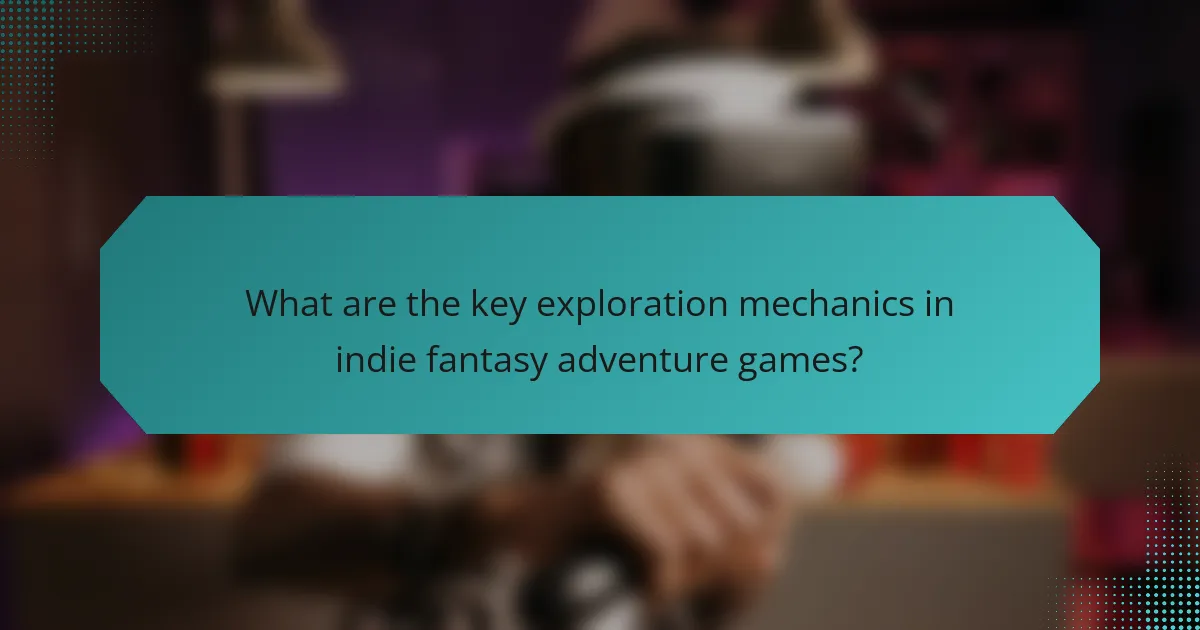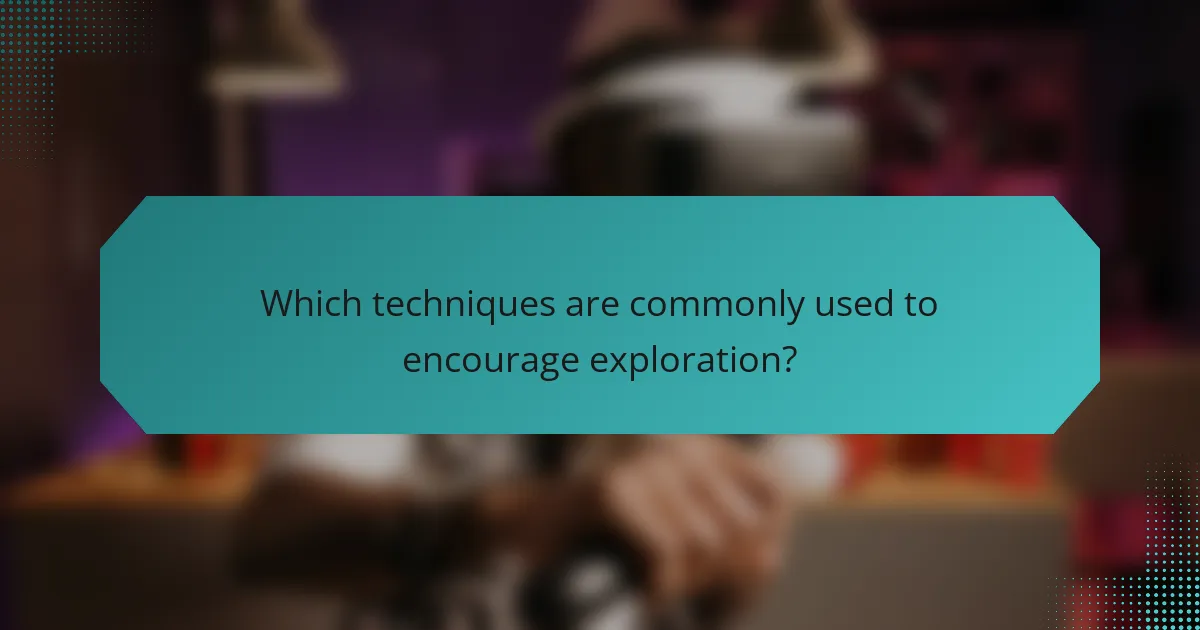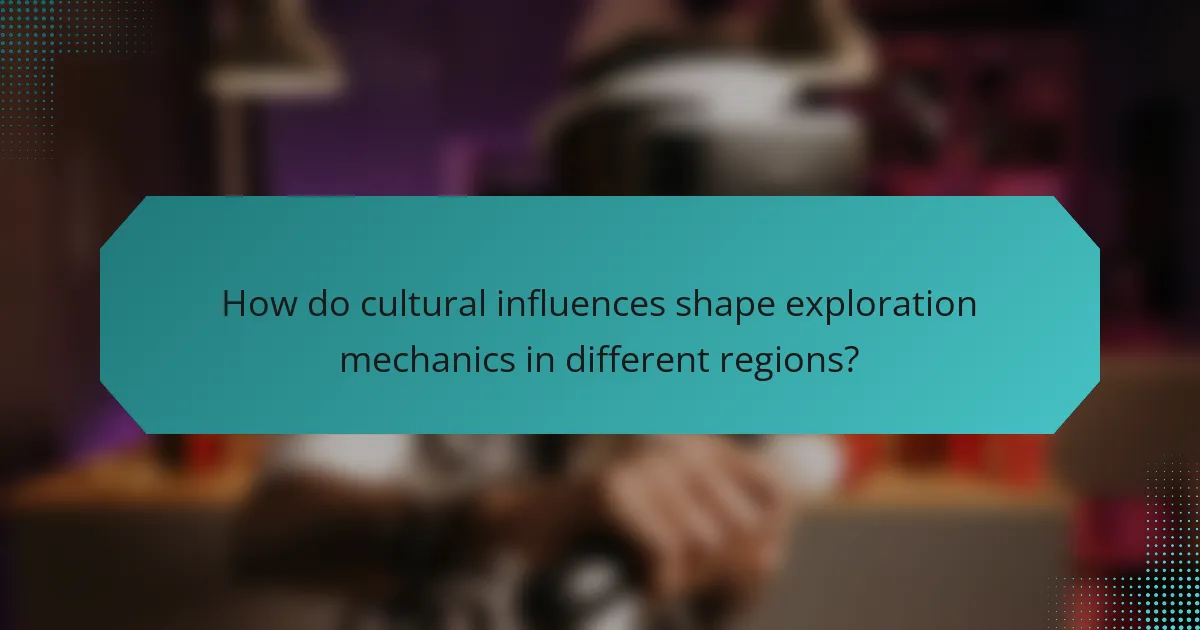Exploration mechanics in indie fantasy adventure games enhance player engagement and immersion. Key techniques include open-world design, environmental storytelling, and dynamic quest systems. Players are rewarded with unique items and lore, fostering agency and replayability. Cultural influences shape these mechanics, leading to varied gameplay experiences across different regions.

What are the key exploration mechanics in indie fantasy adventure games?
Indie fantasy adventure games feature key exploration mechanics that enhance player engagement and immersion. These mechanics include open-world design, environmental storytelling, puzzle-solving elements, and dynamic quest systems.
Open-world design allows players to navigate vast landscapes, discovering hidden areas and lore. Environmental storytelling immerses players in the game world through visual cues and interactive elements. Puzzle-solving elements challenge players, rewarding them with unique items or story progression. Dynamic quest systems adapt to player choices, enhancing agency and replayability.
Together, these mechanics create a rich exploration experience that captivates players and encourages deeper interaction with the game world.
How do exploration mechanics enhance player immersion?
Exploration mechanics significantly enhance player immersion by fostering a sense of discovery and agency. These mechanics encourage players to engage with the game world, uncover hidden secrets, and interact with diverse environments. Techniques such as environmental storytelling and dynamic world-building create a rich narrative that pulls players deeper into the experience. Rewards for exploration, including unique items and lore, further motivate players to explore thoroughly. This combination of agency and reward leads to a more meaningful connection with the game.
What role does environmental storytelling play in exploration?
Environmental storytelling enhances exploration by immersing players in rich narratives and world-building. It creates a sense of place and encourages curiosity, leading to deeper engagement. Players discover lore through environmental cues, which rewards exploration with context and meaning. This technique fosters player agency, allowing choices that impact the narrative experience. Unique attributes, such as hidden details or interactive elements, further enhance the exploration mechanics in indie fantasy adventure games.

Which techniques are commonly used to encourage exploration?
Common techniques to encourage exploration in indie fantasy adventure games include environmental storytelling, dynamic quests, and hidden rewards. Environmental storytelling uses visuals and atmospheric elements to guide players. Dynamic quests adapt to player choices, enhancing engagement. Hidden rewards incentivize thorough exploration, providing unique items or lore. These techniques foster player agency and create immersive experiences.
How do procedural generation and handcrafted worlds differ in exploration?
Procedural generation offers dynamic, unpredictable environments, while handcrafted worlds provide curated, intentional experiences. Procedural worlds often enhance replayability through varied landscapes, but may lack narrative depth. Handcrafted designs prioritize storytelling and player immersion, fostering emotional connections. Each approach shapes player agency differently, influencing exploration satisfaction.
What are the benefits of open-world versus linear exploration?
Open-world exploration offers greater freedom and immersion compared to linear exploration, allowing players to engage with the game environment more dynamically. Open-world mechanics encourage player agency through non-linear quests and discovery, enhancing the overall experience. In contrast, linear exploration provides structured narratives and focused objectives, which can streamline gameplay but may limit player creativity. Players often find that open-world environments yield richer rewards, such as hidden treasures and diverse interactions, compared to the more predictable outcomes in linear settings.

What types of rewards can players expect from exploration?
Players can expect various rewards from exploration, including unique items, lore, and environmental storytelling. These rewards enhance player agency and immersion, making exploration a vital aspect of gameplay. Players may discover rare artifacts that boost abilities or unlock new quests, enriching their adventure experience. Additionally, uncovering hidden areas often leads to narrative insights, deepening the game’s lore and player connection to the world.
How do collectibles and hidden items impact player experience?
Collectibles and hidden items significantly enhance player experience by encouraging exploration and rewarding curiosity. They create a sense of achievement and provide narrative depth, enriching gameplay. Players feel a greater sense of agency as they uncover secrets, leading to increased engagement and satisfaction. This dynamic fosters a deeper connection to the game world.
What is the significance of narrative rewards in exploration mechanics?
Narrative rewards in exploration mechanics enhance player engagement by providing meaningful context and emotional investment. These rewards can manifest as story progression, character development, or world-building elements. Players are motivated to explore when they perceive that their actions yield significant narrative outcomes. This connection between exploration and storytelling fosters a deeper sense of agency, making the gameplay experience more immersive and rewarding. By intertwining narrative with exploration, indie fantasy adventure games create a compelling environment that encourages players to discover and interact with the game world.

How does player agency influence exploration outcomes?
Player agency significantly enhances exploration outcomes by allowing players to make meaningful choices. This autonomy fosters deeper engagement and personal investment in the game world. Players can shape their journey, impacting narrative paths and discovering unique rewards. Increased agency leads to varied exploration experiences, as players approach challenges and environments in ways that reflect their preferences and play styles. This dynamic contributes to the overall replayability and richness of indie fantasy adventure games.
What choices do players face when exploring in these games?
Players face choices that impact exploration, including navigation methods, resource management, and decision-making in quests. These choices affect gameplay experience and player agency, allowing for unique paths and outcomes. Players can opt for stealth, combat, or diplomacy, influencing interactions with NPCs and the environment. The rewards for exploration vary, ranging from collectibles to story progression, enhancing engagement and replayability.
How do different player styles affect exploration strategies?
Different player styles significantly influence exploration strategies in indie fantasy adventure games. Aggressive players often prioritize combat and quick rewards, while exploratory players focus on uncovering lore and hidden areas, leading to varied experiences.
For example, a player who embraces a stealthy approach may prioritize stealth mechanics and environmental interactions, discovering secrets that others might miss. Conversely, a player favoring direct confrontation might overlook subtle narrative elements in favor of immediate action.
These differing styles create diverse exploration dynamics, impacting game design elements like level layout, resource distribution, and narrative pacing. Games that accommodate multiple player styles tend to offer richer, more engaging experiences, enhancing player agency and satisfaction.

What are some unique exploration mechanics found in notable indie titles?
Unique exploration mechanics in notable indie fantasy adventure games often enhance player engagement and provide distinct experiences. Examples include procedurally generated environments that offer fresh landscapes with each playthrough, encouraging discovery.
Another technique is the use of environmental storytelling, where players uncover narratives through the world itself rather than traditional dialogue. This mechanic deepens immersion and player agency.
Additionally, some games incorporate unique traversal methods, such as grappling hooks or teleportation, allowing players to navigate in innovative ways. These mechanics not only challenge players but also reward them with hidden areas and collectibles.
Lastly, dynamic weather systems can influence gameplay, impacting visibility and interactions. This rare attribute creates a living world that reacts to player actions, enhancing the exploratory experience.
How does ‘Hollow Knight’ utilize exploration to enhance gameplay?
‘Hollow Knight’ enhances gameplay through exploration by creating a rich, interconnected world that rewards curiosity and player agency. Players discover hidden areas, unlock abilities, and encounter diverse characters, which deepen engagement. This design fosters a sense of accomplishment and encourages thorough exploration, leading to unique encounters and lore revelations. The game’s map system provides guidance while still allowing for personal discovery, reinforcing the exploration mechanics as central to the overall experience.
What innovative approaches to exploration are seen in ‘Celeste’?
Celeste employs innovative exploration mechanics through verticality, environmental storytelling, and player agency. The game emphasizes climbing mechanics, allowing players to navigate challenging terrains creatively. Environmental storytelling immerses players in the narrative, revealing character backstories and emotional depth through the world itself. Additionally, player agency is highlighted by choices that affect gameplay, enhancing the exploration experience.

How do cultural influences shape exploration mechanics in different regions?
Cultural influences significantly shape exploration mechanics in indie fantasy adventure games by affecting narrative styles, environmental design, and player agency. Different regions often incorporate unique folklore and traditions, leading to distinct gameplay experiences. For instance, Japanese games may emphasize harmony and nature, while Western titles often focus on individualism and conflict. These cultural narratives influence how players interact with the game world, shaping mechanics like quest structures and exploration incentives. As a result, players experience varied rewards and challenges that reflect their cultural backgrounds, enhancing immersion and engagement.
What regional variations exist in player expectations for exploration?
Player expectations for exploration vary significantly across regions due to cultural influences and gaming trends. In North America, players often seek open-world experiences with extensive freedom and diverse environments. Conversely, European players may prioritize narrative depth and environmental storytelling in exploration. Asian markets frequently emphasize structured quests and rewards tied to exploration, reflecting preferences for progression systems. These regional differences shape game design, influencing mechanics and player agency. Understanding these variations enhances the development of indie fantasy adventure games, ensuring they resonate with diverse audiences.
How do indie developers adapt exploration mechanics for local audiences?
Indie developers adapt exploration mechanics for local audiences by incorporating culturally relevant narratives and gameplay elements. They often research local myths, traditions, and landscapes to create immersive experiences that resonate with players.
For example, developers may modify quest structures to reflect local storytelling styles or integrate familiar environmental features, enhancing player connection. This approach fosters engagement and encourages exploration through relatable content.
Additionally, localizing game mechanics, such as puzzles or challenges, ensures they are culturally appropriate and accessible. By tailoring rewards to local preferences, developers further incentivize exploration, making the experience rewarding and enjoyable for diverse audiences.
What best practices can enhance exploration mechanics in indie games?
Incorporating best practices can significantly enhance exploration mechanics in indie fantasy adventure games. Focus on creating diverse environments, integrating meaningful rewards, and promoting player agency.
1. Design unique landscapes that encourage curiosity and discovery.
2. Implement dynamic events that respond to player actions.
3. Offer rewards that enhance gameplay, such as new abilities or lore.
4. Allow players to make impactful choices that shape their journey.
5. Use environmental storytelling to immerse players in the world.
These techniques foster engagement and deepen the exploration experience.